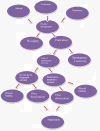The care process of diabetic foot ulcer patients: a qualitative study in Iran
- PMID: 23497621
- PMCID: PMC3598830
- DOI: 10.1186/2251-6581-11-27
The care process of diabetic foot ulcer patients: a qualitative study in Iran
Abstract
Background: The Purpose of this study is to clarify the care process for Iranian diabetic patients with diabetic foot ulcer condition.
Methods: The main question of this research was "How is the care process for diabetic foot ulcer patients and how do patients experience it?" This study was within the Grounded Theory method. Data collection was carried out until data saturation was achieved. Saturation was achieved after interviewing 11 patients, 4 physicians, one head nurse and one nurse.
Results: Three main themes emerged from this study, including: "disease management, disease experience and continuity of care". Each of these themes is consisted of different sub-themes.
Conclusions: This is the first study to describe the care process in Iranian diabetic patients with diabetic foot ulcer disease. Knowing patients' experience and the manner of dealing with them once faced with foot ulcer condition could facilitate a comprehensive decision making by therapists and better recovery of diabetic patients.
Figures



Similar articles
-
Implementation of evidence-based nursing practice for diabetic patients: an Iranian experience.Int J Nurs Pract. 2013 Sep;19 Suppl 3:73-80. doi: 10.1111/ijn.12170. Int J Nurs Pract. 2013. PMID: 24090300
-
Management of diabetic foot ulcer in Babol, North of Iran: an experience on 520 cases.Caspian J Intern Med. 2012 Summer;3(3):456-9. Caspian J Intern Med. 2012. PMID: 24009914 Free PMC article.
-
Risk factors associated with diabetic foot ulcer-free survival in patients with diabetes.Diabetes Metab Syndr. 2018 Nov;12(6):1039-1043. doi: 10.1016/j.dsx.2018.06.020. Epub 2018 Jun 26. Diabetes Metab Syndr. 2018. PMID: 30168426
-
Diabetic foot ulcer care: a concept analysis of the term integrated into nursing practice.Scand J Caring Sci. 2019 Jun;33(2):298-310. doi: 10.1111/scs.12645. Epub 2019 Jan 3. Scand J Caring Sci. 2019. PMID: 30604889 Review.
-
Systematic reviews of wound care management: (3) antimicrobial agents for chronic wounds; (4) diabetic foot ulceration.Health Technol Assess. 2000;4(21):1-237. Health Technol Assess. 2000. PMID: 11074391 Review.
Cited by
-
A social network analysis on clinical education of diabetic foot.J Diabetes Metab Disord. 2013 Sep 20;12(1):44. doi: 10.1186/2251-6581-12-44. J Diabetes Metab Disord. 2013. PMID: 24330538 Free PMC article.
-
Predictive Role of Preventive Measures in Preventing the Progression of Diabetic Foot.Mater Sociomed. 2015 Aug;27(4):234-6. doi: 10.5455/msm.2015.27.234-236. Mater Sociomed. 2015. PMID: 26543412 Free PMC article.
-
Perceptions and experiences of diabetic foot ulceration and foot care in people with diabetes: A qualitative meta-synthesis.Int Wound J. 2019 Feb;16(1):183-210. doi: 10.1111/iwj.13010. Epub 2018 Nov 4. Int Wound J. 2019. PMID: 30393976 Free PMC article. Review.
-
Health literacy and cognitive function in people with diabetic foot ulcer with focus on knowledge, attitude, and practice in relation to foot self-care.SAGE Open Med. 2024 Jun 6;12:20503121241258841. doi: 10.1177/20503121241258841. eCollection 2024. SAGE Open Med. 2024. PMID: 38855003 Free PMC article.
-
Challenges of managing diabetes in Iran: meta-synthesis of qualitative studies.BMC Health Serv Res. 2020 Jun 12;20(1):534. doi: 10.1186/s12913-020-05130-8. BMC Health Serv Res. 2020. PMID: 32532266 Free PMC article.
References
-
- Edwards L. Practical advice for the effective application of compression bandaging. J Community Nurs. 2003. online.
-
- Searle A, Campbell R, Tallon D. A Qualitative Approach to Understanding the Experience of Ulceration and Healing in the Diabetic Foot: Patient and Podiatrist prespective, wounds. 2005. pp. 16–26.
LinkOut - more resources
Full Text Sources

